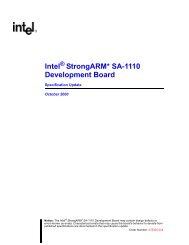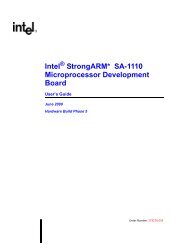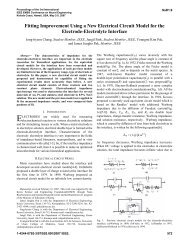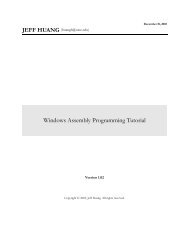Beej’s <strong>Guide</strong> <strong>to</strong> <strong>Network</strong> <strong>Programming</strong> <strong>Using</strong> <strong>Internet</strong> <strong>Sockets</strong> 5How do stream sockets achieve this high level of data transmission quality? They use apro<strong>to</strong>col called “The Transmission Control Pro<strong>to</strong>col”, otherwise known as “TCP” (see RFC-793 5for extremely detailed info on TCP.) TCP makes sure your data arrives sequentially and error-free.You may have heard “TCP” before as the better half of “TCP/IP” where “IP” stands for “<strong>Internet</strong>Pro<strong>to</strong>col” (see RFC-791 6 .) IP deals primarily with <strong>Internet</strong> routing and is not generally responsiblefor data integrity.Cool. What about Datagram sockets? Why are they called connectionless? What is the deal,here, anyway? Why are they unreliable? Well, here are some facts: if you send a datagram, it mayarrive. It may arrive out of order. If it arrives, the data within the packet will be error-free.Datagram sockets also use IP for routing, but they don’t use TCP; they use the “User DatagramPro<strong>to</strong>col”, or “UDP” (see RFC-768 7 .)Why are they connectionless? Well, basically, it’s because you don’t have <strong>to</strong> maintain anopen connection as you do with stream sockets. You just build a packet, slap an IP header on itwith destination information, and send it out. No connection needed. They are generally used forpacket-by-packet transfers of information. Sample applications: tftp, bootp, etc.“Enough!” you may scream. “How do these programs even work if datagrams might getlost?!” Well, my human friend, each has it’s own pro<strong>to</strong>col on <strong>to</strong>p of UDP. For example, the tftppro<strong>to</strong>col says that for each packet that gets sent, the recipient has <strong>to</strong> send back a packet that says, “Igot it!” (an “ACK” packet.) If the sender of the original packet gets no reply in, say, five seconds,he’ll re-transmit the packet until he finally gets an ACK. This acknowledgment procedure is veryimportant when implementing SOCK_DGRAM applications.2.2. Low level Nonsense and <strong>Network</strong> TheorySince I just mentioned layering of pro<strong>to</strong>cols, it’s time <strong>to</strong> talk about how networks really work,and <strong>to</strong> show some examples of how SOCK_DGRAM packets are built. Practically, you can probablyskip this section. It’s good background, however.Data Encapsulation.Hey, kids, it’s time <strong>to</strong> learn about Data Encapsulation! This is very very important. It’s soimportant that you might just learn about it if you take the networks course here at Chico State ;-).Basically, it says this: a packet is born, the packet is wrapped (“encapsulated”) in a header (andrarely a footer) by the first pro<strong>to</strong>col (say, the TFTP pro<strong>to</strong>col), then the whole thing (TFTP headerincluded) is encapsulated again by the next pro<strong>to</strong>col (say, UDP), then again by the next (IP), thenagain by the final pro<strong>to</strong>col on the hardware (physical) layer (say, Ethernet).When another computer receives the packet, the hardware strips the Ethernet header, the kernelstrips the IP and UDP headers, the TFTP program strips the TFTP header, and it finally has thedata.5 http://www.rfc-edi<strong>to</strong>r.org/rfc/rfc793.txt6 http://www.rfc-edi<strong>to</strong>r.org/rfc/rfc791.txt7 http://www.rfc-edi<strong>to</strong>r.org/rfc/rfc768.txt
Beej’s <strong>Guide</strong> <strong>to</strong> <strong>Network</strong> <strong>Programming</strong> <strong>Using</strong> <strong>Internet</strong> <strong>Sockets</strong> 6Now I can finally talk about the infamous Layered <strong>Network</strong> Model. This <strong>Network</strong> Modeldescribes a system of network functionality that has many advantages over other models. Forinstance, you can write sockets programs that are exactly the same without caring how the data isphysically transmitted (serial, thin Ethernet, AUI, whatever) because programs on lower levels dealwith it for you. The actual network hardware and <strong>to</strong>pology is transparent <strong>to</strong> the socket programmer.Without any further ado, I’ll present the layers of the full-blown model. Remember this fornetwork class exams:• Application• Presentation• Session• Transport• <strong>Network</strong>• Data Link• PhysicalThe Physical Layer is the hardware (serial, Ethernet, etc.). The Application Layer is justabout as far from the physical layer as you can imagine–it’s the place where users interact with thenetwork.Now, this model is so general you could probably use it as an au<strong>to</strong>mobile repair guide if youreally wanted <strong>to</strong>. A layered model more consistent with Unix might be:• Application Layer (telnet, ftp, etc.)• Host-<strong>to</strong>-Host Transport Layer (TCP, UDP)• <strong>Internet</strong> Layer (IP and routing)• <strong>Network</strong> Access Layer (Ethernet, ATM, or whatever)At this point in time, you can probably see how these layers correspond <strong>to</strong> the encapsulationof the original data.See how much work there is in building a simple packet? Jeez! And you have <strong>to</strong> type in thepacket headers yourself using “cat”! Just kidding. All you have <strong>to</strong> do for stream sockets is send()the data out. All you have <strong>to</strong> do for datagram sockets is encapsulate the packet in the method ofyour choosing and send<strong>to</strong>() it out. The kernel builds the Transport Layer and <strong>Internet</strong> Layer onfor you and the hardware does the <strong>Network</strong> Access Layer. Ah, modern technology.So ends our brief foray in<strong>to</strong> network theory. Oh yes, I forgot <strong>to</strong> tell you everything I wanted<strong>to</strong> say about routing: nothing! That’s right, I’m not going <strong>to</strong> talk about it at all. The router stripsthe packet <strong>to</strong> the IP header, consults its routing table, blah blah blah. Check out the IP RFC 8 if youreally really care. If you never learn about it, well, you’ll live.8 http://www.rfc-edi<strong>to</strong>r.org/rfc/rfc791.txt












